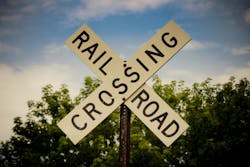At a Crossing: Need For Safety Improvements Shouldn’t Be Ignored
With more than 200,000 public and private at-grade rail crossings in the United States, safety should be a paramount concern for local, state and federal transportation officials, companies and organizations.
Every day, thousands of commuter, local and freight trains pass through these crossings, as do millions of vehicles and pedestrians.
Yet, for too many of these crossings and for the trains themselves, organizations have not made the needed investments to accommodate new safety requirements, best practices for design, advancements in technology and changes in ground transportation.
This neglect and lack of investment creates vast potential for tragedy. Worse, these are deadly interactions that in many cases could have been avoided.
In one recent incident, a tour bus became stuck on a crossing in Biloxi, Mississippi, when its undercarriage high-centered on the tracks. The bus was then broadsided by an oncoming freight train, killing 4 passengers.
While the NTSB is still investigating, preliminary indications are that the vertical rise in the crossing caused the bus to get stuck, effectively turning the bus into a giant teeter-totter as the undercarriage stuck on the crossing’s apex.
Once stuck, the bus had no chance to avoid a crash with the approaching train. Even though the freight train was moving relatively slowly, it still hit the bus with terrific force, killing and injuring passengers as it pushed the bus for hundreds of feet down the tracks.
Tragedies like this remind us that rail crossings present a constant challenge for rail operators and the local jurisdictions that together must build and maintain the crossings. Too often, despite the potential for tragic interactions between trains, vehicles and pedestrians, the crossings have received too little investment and too few upgrades for years.
At a time when the administration is seeking funding for as much as $1 trillion in infrastructure investments, rail crossings should be a top priority; and that investment should include more than some new construction.
New technology is in development that will give train operators far faster warning when a car, truck or debris is blocking tracks ahead. The quicker warnings can give operators crucial time to slow and stop their trains, averting a collision.
This technology, the first of its kind to reduce the potential for rail-crossing disasters, will be a critical upgrade when it reaches the market.
Regardless of timing on installation of these systems, however, rail companies and local jurisdictions should make safety upgrades for crossings a top priority. Contractors, builders and others that can help build these upgrades should actively push for the investments as well.
And yes, drivers and pedestrians need to exercise great care when they cross rail lines, but not everyone exercises that care. Just as importantly, even when drivers do their part, as the Biloxi incident suggests, tragedy can still happen when crossings can’t accommodate modern vehicles and design.
Few other infrastructure investments can have as big a payoff in protecting people from tragedy while helping stimulate the economy with new projects. As the country seeks ways to improve its infrastructure, investing in safety is always a winner.
Keith Millhouse, a principal at Millhouse Strategies, is an attorney, government relations and transportation/infrastructure consultant based in Southern California. He can be reached for business inquires at [email protected]
About the Author

Keith Millhouse
Principal
Keith Millhouse, a principal at Millhouse Strategies, is an attorney, government relations and transportation/infrastructure consultant based in Southern California.
